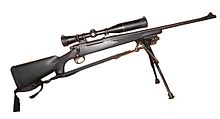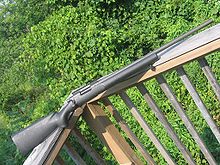
In firearm designs, the term single-shot refers to guns that can hold only a single round of ammunition inside and thus must be reloaded manually after every shot. Compared to multi-shot repeating firearms ("repeaters"), single-shot designs have no moving parts other than the trigger, hammer/firing pin or frizzen, and therefore do not need a sizable receiver behind the barrel to accommodate a moving action, making them far less complex and more robust than revolvers or magazine/belt-fed firearms, but also with much slower rates of fire.

Bolt-action is a type of manual firearm action that is operated by directly manipulating the bolt via a bolt handle, which is most commonly placed on the right-hand side of the firearm.
A semi-automatic firearm, also called a self-loading or autoloading firearm, is a repeating firearm whose action mechanism automatically loads a following round of cartridge into the chamber and prepares it for subsequent firing, but requires the shooter to manually actuate the trigger in order to discharge each shot. Typically, this involves the weapon's action utilizing the excess energy released during the preceding shot to unlock and move the bolt, extracting and ejecting the spent cartridge case from the chamber, re-cocking the firing mechanism, and loading a new cartridge into the firing chamber, all without input from the user. To fire again, however, the user must actively release the trigger, allow it to "reset", before pulling the trigger again to fire off the next round. As a result, each trigger pull only discharges a single round from a semi-automatic weapon, as opposed to a fully automatic weapon, which will shoot continuously as long as the ammunition is replete and the trigger is kept depressed.
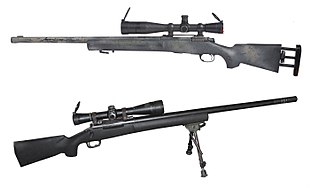
A sniper rifle is a high-precision, long-range rifle. Requirements include high accuracy, reliability, and mobility, concealment, and optics, for anti-personnel, anti-materiel and surveillance uses by military snipers. The modern sniper rifle is a portable shoulder-fired rifle with either a bolt action or semi-automatic action, fitted with a telescopic sight for extreme accuracy and chambered for a high-ballistic performance centerfire cartridge.

The M24 Sniper Weapon System (SWS) or M24 is the military and police version of the Remington Model 700 rifle, M24 being the model name assigned by the United States Army after adoption as their standard sniper rifle in 1988. The M24 is referred to as a "weapon system" because it consists of not only a rifle, but also a detachable telescopic sight and other accessories.
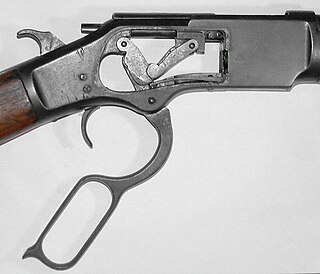
A lever action is a type of action for repeating firearms that uses a manually operated cocking handle located around the trigger guard area that pivots forward to move the bolt via internal linkages, which will feed and extract cartridges into and out of the chamber, and cock the firing pin mechanism. This contrasts to other type of repeating actions such as the bolt-action, pump-action, semi-automatic, fully automatic, and/or burst mode actions. A firearm using this operating mechanism is colloquially referred to as a levergun.
The Accuracy International Arctic Warfare rifle is a bolt-action sniper rifle designed and manufactured by the British company Accuracy International. It has proved popular as a civilian, police, and military rifle since its introduction in the 1980s. The rifles have some features that improve performance in very cold conditions without impairing operation in less extreme conditions.
The M40 rifle is a bolt-action sniper rifle used by the United States Marine Corps. It has had four variants: the M40, M40A1, M40A3, and M40A5. The M40 was introduced in 1966. The changeover to the A1 model was completed in the 1970s, the A3 in the 2000s, and the A5 in 2009.
The Winchester Model 70 is a bolt-action sporting rifle. It has an iconic place in American sporting culture and has been held in high regard by shooters since it was introduced in 1936, earning the moniker "The Rifleman's Rifle". The action has some design similarities to Mauser designs and it is a development of the earlier Winchester Model 54, itself being based on a Mauser 98–type action.

The M1917 Enfield, the "American Enfield", formally named "United States Rifle, cal .30, Model of 1917" is an American modification and production of the .303-inch Pattern 1914 Enfield (P14) rifle, which was developed and manufactured during the period 1917–1918. Numerically, it was the main rifle used by the American Expeditionary Forces in Europe during World War I. The Danish Sirius Dog Sled Patrol on Greenland still use the M1917, which performs reliably in Arctic conditions, as their service weapon.
The SSG 69 is a bolt-action sniper rifle produced by Steyr Mannlicher that serves as the standard sniper rifle for the Austrian Army.
The Sako TRG is a bolt-action sniper rifle line designed and manufactured by Finnish firearms manufacturer SAKO of Riihimäki. It is the successor to the SAKO TR-6 target rifle, and thus the letter G within the rifle's name is meant to represent number 7.
The CZ-550 is a bolt-action hunting rifle series manufactured by Česká zbrojovka Uherský Brod. The CZ 550 series is available with a medium or magnum sized action. The CZ 550 rifle is based on the Mauser 98 rifle.

The .338 Norma Magnum is a cartridge first introduced in 2008 and came into production in 2009, designed by Norma of Sweden.
The Howa 1500 or Howa M1500 is a bolt-action rifle produced in Japan by Howa Machinery. Introduced in 1979, it has been used by hunters as a hunting rifle with various cartridge offerings. It is also utilized by military and law enforcement elements as a sniper rifle. It is sold under the name of Howa Model 1500 Rifle for overseas markets.
The M2010 Enhanced Sniper Rifle (ESR), formerly known as the XM2010 and M24 Reconfigured Sniper Weapon System, is a sniper rifle developed by PEO Soldier for the United States Army. It is derived from and replaced the M24 Sniper Weapon System, and was designed to give snipers longer range in the mountainous and desert terrain of the War in Afghanistan. After winning a competitive bidding process, Remington was awarded the production contract for up to 3,600 weapons. The Army had anticipated sending the upgraded weapons to deployed snipers in late 2010, but later expected fielding would happen in January 2011. The M2010 fires .300 Winchester Magnum (7.62×67mm) ammunition, which offers about 50 percent more effective range than the M24's 7.62×51mm NATO. This chambering to dimensionally larger cartridges is possible because the M24 was designed to use the "long action" bolt version of the Remington 700 receiver for cartridges up to 3.34 inches (84.84 mm) in overall length.
The Modular Sniper Rifle, or MSR, is a bolt-action sniper rifle developed and produced by Remington Arms for the United States Army. It was introduced in 2009, and was designed to meet specific United States Army and USSOCOM Precision Sniper Rifle requirements. The MSR initially won the PSR competition, and was called the Remington Mk 21 Precision Sniper Rifle in U.S. military service. However, it was then decided that the Mk 21 did not conform to SOCOM requirements at the time in 2018, and the program was re-competed with the Barrett MRAD selected in 2019 as the Mk 22 Advanced Sniper Rifle solution.
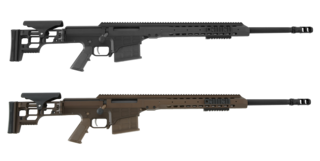
The Barrett MRAD is a bolt-action sniper rifle designed by Barrett to meet the requirements of the SOCOM PSR. The MRAD is based on the Barrett 98B and includes a number of modifications and improvements. The Barrett MRAD was named the 2012 Rifle of the Year by the NRA.
The Model 721 and Model 722 along with the later Model 725 variant are bolt-action sporting rifles manufactured by Remington Arms from 1948 until 1961. The 721/722 replaced the short-lived Model 720. The Model 721/722 is considered to be one of the first modern, economically produced sporting rifles whose design largely continued with the subsequent and highly successful Model 700. Manufactured with high precision, it is known for exceptional accuracy. The bolt and receiver design, based on the Mauser action, is considered one of the strongest ever produced. Samples in excellent condition have become collectible.

The MK 13 rifle is made using the Accuracy International Chassis System (AICS) version 2.0 mated to a long action Remington 700 receiver. The AICS 2.0 folding stock reduces the rifle's overall length by 210 mm (8.3 in) when folded and adds 0.2 kg (0.44 lb) to the rifle's total weight. The rifle has a cheekpiece design that adjusts sideways and for height for optimal cheek position when using night vision equipment or telescopic sights with large objective lenses. There is also a quick-adjust cheek-piece option that has a spring-loaded cheek-piece in conjunction with a quick-adjust butt plate. The side panels are made from a high-strength polymer and are available in the colors olive drab, dark earth or black. Sling attachment points are mounted on each side of the rifle, so it can be carried flat against the back and used comfortably by left- and right-handed users. A front attachment point is situated below the fore-end and can be used to anchor a target-style sling or replaced by an adapter for a Harris bipod.
